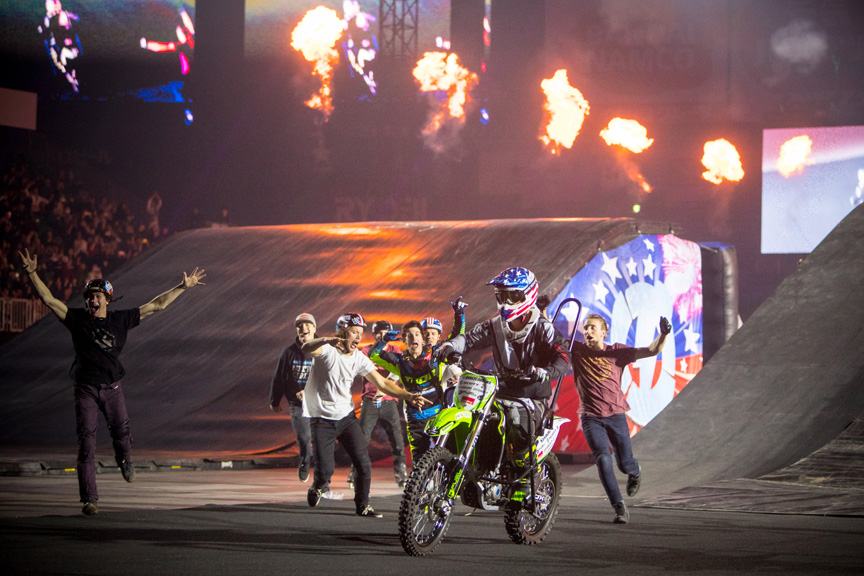Back in 2014, freestyle motocross rider Bruce Cook was attempting the biggest trick in the world of action sports at the time, a double front flip on a dirt bike.

Little did he know his life would change forever as he rode out in front of thousands of screaming fans on his first show with Nitro Circus Live, the global action sports tour started by Travis Pastrana featuring the world’s top motocross riders and action sports athletes.
Bruce crash landed mid-flip on the second rotation and broke his T11 vertebrae. He was immediately paralyzed from the waist down. Fast-forward to 2017 and the 29-yearold is back, again attempting a world record as the first paraplegic to successfully backflip a dirt bike.
Bruce joined Nitro Circus for its second tour to Japan and discussed his miraculous comeback with Outdoor Japan.
Rie Miyoshi: Most people would have quit the world of action sports after an accident such as yours. What got you back on the bike?
Bruce Cook: I’ve been through a lot of injuries in the past. For example, when I broke my wrist, the first question in my mind was, “How long until I can get back on a bike?” It was no different when I broke my back. I just wanted to ride again and figure out how to recover the fastest, so I worked hard in physio and rehab because I had a goal in mind.
RM: Did your upbringing influence your outlook on life?
BC: I would say so. I’m from Kelowna in British Columbia (Canada) and, growing up on a farm, I was used to hard work. It was never a question of whether I could get stuff done; it was more about how could I do it. If I worked hard enough, I could get it done. Never giving up was a natural thing for me.
RM: When did you first start riding?
BC: I’ve been on a dirt bike ever since I was 5. It was a natural progression, I just liked the adrenaline and spent a lot of time at the dirt bike tracks. I didn’t really like the tracks when I practiced tricks and big jumps, so I built my own track at my parents’ place. It was what I loved to do.
RM: Does anyone else in your family ride?
BC: No, I’m the only one. My parents bought a little 50-cc. bike from my cousins to get them out of a tight spot and have a dirt bike around the farm. Then I just took to it and didn’t put it down.
RM: How long did it take to get back on your bike after your accident?
BC: I was in recovery for three months. In the meantime, my good friend Billy Van Vugt (a fabricator for Nitro Circus) and I had never talked about a modified bike, but he knew what I was thinking and how I wanted to ride again. So he started designing, figuring what fit me best and how my legs would be protected. Nine months after my injury, I was back on a dirt bike. Back flipped into a foam pit on my first day successfully and a dirt ramp three days later.
RM: Can you tell me a bit about the bike you’re riding now?
BC: Billy owns a fabrication shop, and I went out there while he was building this bike for me. It’s the one I’m riding now – and it worked the first time we tried it. There’s the bit which protects my legs: I did my first flip with just this leg protection part but, for the tour, we customized it to protect my body better, especially if I crash and can’t feel if my legs are broken.
There are little stirrups holding my feet in place, leg straps and the seat belt. This is the scariest part because it means I’m attached solid to my bike. There’s also a roll cage, a small roll bar sticking out in the back; it doesn’t cover my head but is high enough so, if I were to land upside-down, I’d be safe. I need someone or something to lean against when I start and finish riding, and in between I have to keep my balance. It’s nerve-wracking to be strapped to a 250-pound bike, but at the same time, I’m confident.

RM: I noticed you don’t need a lot of momentum to flip the bike; you speed up right as you hit the ramp.
BC: I’m basically doing a wheelie off the ramp and relying on my bike’s power. The ramp for the show is steeper than the rest and I start slow before giving it full throttle at the last minute. I can’t use my legs at all, so I’m 100 percent relying on my arms, pulling as hard as I can, which is what gets the rotation.
RM: Do you have a lot of time to practice?
BC: I practice at my parents’ place – the track’s still there, but because I’m not home often, the only time I flip a bike is during the show.
RM: Are there other tricks or tweaks you’re working on currently?
BC: Some variations like one-handers, but I’m letting this backflip ride out. When I get home, I want to get on snowmobiles and downhill mountain biking. We’re also going to lift the bottom cage a little higher, so it doesn’t hit the ground, but I think it’s pretty cool we nailed the bike on the first design. I’ve been busy touring with Nitro Circus though, which has been a lot of fun.
RM: How did you get involved with Nitro Circus?
BC: Billy’s sister Jolene was part of the original Nitro Circus show. In 2008, I wanted to learn a backflip, so I asked Jolene if I could go over to Travis’ (Pastrana) place. I still see Billy and Jolene quite a bit, even though we’re all traveling and working on separate projects now. Nitro is my extended family, and they are so supportive. Naturally people were hesitant about me getting on a bike, but they knew I was going to do it anyway, so they supported me.
RM: And this is your first time in Japan?
BC: It’s my first time in Asia actually. I’ve only heard good things and am definitely excited I got to see the sites. Everything’s so clean, and people have been friendly. Tokyo’s population is mind-blowing; so many people in a small area compared to back home where it’s just wide open fields. It’s been incredible.
Bruce and the Nitro Circus team continue their tour in Australia and America with more than 40 shows through Autumn. For more information on Nitro Circus and tour details visit here.




